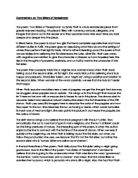Plath creates imagery in many of her poems with the use of colour. In Daddy she patterns the use of colour from black and white in the first stanza to black and red in the eleventh and twelfth stanza. The colours black and white are antithetical and when placed in close proximity connote racism, or in this case fascism. The black is used to connote the evil of the Germans while the white represents the innocence of the Jews. Therefore Plath is using colours to create imagery of her view of the suppression of the Jews, this creates an empathetic impact on the reader.
However, the later patterning of black and red are used symbolically. She writes, “Bit my pretty red heart in two.” The adjective she has used to describe her heart is ‘red’ but in the last line her use of the adjective black is also linked to the description of the heart symbolising that her heart is black, which connotes death. This imagery is very emotive; therefore, creating a significant impact on the reader.
Furthermore, in this poem Plath uses the linguistic device of apostrophe to create an impact on the reader. She writes, “Daddy, I have had to kill you.” This device conveys to the reader that this poem is addressed to her Father. Many of Plath’s poems are about her father but the device of directing this poem at him has a much stronger effect on the reader because she speaks so openly to him in the poem, even though the reader may be aware of the fact that he is dead.
Plath patterns the pronoun ‘you’ to sustain the direct address of her father throughout the poem. However, she also used this pronoun with a concealed intention as it seems also to be addressing the reader. The last stanza use the pronoun in every line, “There’s a stake in your fat black heart
And the villagers never liked you……”
This patterning of the pronoun includes the reader because it seems as though she is subtly talking to the reader of the poem as well. In this case this linguistic device makes a stronger impact on the reader than if Plath were to have written the poem in first or third person because of the emotive nature of much of the lexis in the poem that appears to be directly addressed to the reader.
The lexical field within this poem, as has been the case in some of Plath’s other poetry, is that of war. The phrase, “barb wire snare” and her numerous references to “Jews”, “Germans” and fascism are just some of the lexis that connote that of war. Her overindulgence in lexis from this field is so overwhelmingly hyperbolic that it gives the poem a sarcastic tone. Plath purposefully does this to create a light hearted twist in a poem that on the surface seems to the reader to be very derisive and cruel.
Plath creates a childlike feeling in the thirteenth stanza when she writes, “And they stuck me together with glue.” This line alludes to the children’s poem ‘Humpty Dumpty’ reinforcing the childish noun ‘Daddy’. This juxtaposition of the childlike allusion and lexis with the hard hitting, raw lexical field of war creates a binary opposition. The association of these two opposite images is rather unpleasant making the reader feel uncomfortable.
Plath’s use of enjambment has a strong effect as the poem seems to pour out of Plath and onto the page in a disordered but constant stream of imagery and sadistic phrases. This creates the hateful tone that Plath intentionally uses in some of her other poetry about her Father. Caesura is used to help make the poem somewhat readable but does not break the flow of ‘hate’ that the enjambment creates. The syntax of many of the sentences in the poem is also disordered which adds to this effect. Combined the syntax and enjambment create an impact on the reader because of the overflowing feeling of Plath’s hate that they convey.
In conclusion it is clear to see that the subject of this poem is one that Plath feels incredibly strong emotions towards, in this case hate. It would therefore be impossible to not have some sort of impact on the reader. However, through her use of linguistic and literary devices like assonance, imagery, apostrophe, lexical fields, allusions and enjambment Plath conveys her message and emotions effectively to the reader resulting in a much stronger impact.








